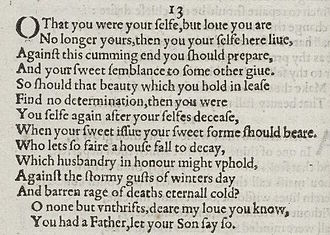
William Shakespeare (1564–1616) wrote sonnets on a variety of themes. When discussing or referring to Shakespeare's sonnets, it is almost always a reference to the 154 sonnets that were first published all together in a quarto in 1609. However, there are six additional sonnets that Shakespeare wrote and included in the plays Romeo and Juliet, Henry V and Love's Labour's Lost. There is also a partial sonnet found in the play Edward III.

Sonnet 1 is one of 154 sonnets written by the English playwright and poet William Shakespeare. It is a procreation sonnet within the Fair Youth sequence.

Sonnet 55 is one of the 154 sonnets published in 1609 by the English playwright and poet William Shakespeare. It is included in what is referred to as the Fair Youth sequence.

Sonnet 11 is one of 154 sonnets written by the English playwright and poet William Shakespeare. It is a procreation sonnet within the 126 sonnets of the Fair Youth sequence, a grouping of Shakespeare's sonnets addressed to an unknown young man. While the order in which the sonnets were composed is undetermined, Sonnet 11 was first published in a collection, the Quarto, alongside Shakespeare's other sonnets in 1609.

Sonnet 12 is one of 154 sonnets written by the English playwright and poet William Shakespeare. It is a procreation sonnet within the Fair Youth sequence.

Sonnet 15 is one of 154 sonnets written by the English playwright and poet William Shakespeare. It forms a diptych with Sonnet 16, as Sonnet 16 starts with "But...", and is thus fully part of the procreation sonnets, even though it does not contain an encouragement to procreate. The sonnet is within the Fair Youth sequence.

Sonnet 36 is one of 154 Shakespeare's sonnets written by the English playwright and poet William Shakespeare. It's a member of the Fair Youth sequence, in which the speaker expresses his love towards a young man.
Sonnet 41 is one of 154 sonnets written by the English playwright and poet William Shakespeare. It is a part of the Fair Youth section of the sonnets addressed to an unnamed young man. While the exact date of the composition is unknown, it was originally published in the 1609 Quarto along with the rest of the sonnets.

Sonnet 42 is one of 154 sonnets written by the English playwright and poet William Shakespeare. It is a part of the Fair Youth section of the sonnets addressed to an unnamed young man.

Sonnet 64 is one of 154 sonnets written by the English playwright and poet William Shakespeare. It is a member of the Fair Youth sequence, in which the poet expresses his love towards a young man.
Sonnet 65 is one of 154 sonnets written by the English playwright and poet William Shakespeare. It is a member of the Fair Youth sequence, in which the poet expresses his love towards a young man.

Sonnet 141 is the informal name given to the 141st of William Shakespeare's 154 sonnets. The theme of the sonnet is the discrepancy between the poet's physical senses and wits (intellect) on the one hand and his heart on the other. The "five wits" that are mentioned refer to the mental faculties of common sense, imagination, fantasy, instinct, and memory. The sonnet is one of several in which the poet's heart is infatuated despite what his eyes can see.

Sonnet 71 is one of 154 sonnets written by the English playwright and poet William Shakespeare. It's a member of the Fair Youth sequence, in which the poet expresses his love towards a young man. It focuses on the speaker's aging and impending death in relation to his young lover.

Sonnet 72 is one of 154 sonnets published by the English playwright and poet William Shakespeare in 1609. It is one of the Fair Youth Sequence, which includes Sonnet 1 through Sonnet 126.

Sonnet 144 was published in the Passionate Pilgrim (1599). Shortly before this, Francis Meres referred to Shakespeare's Sonnets in his handbook of Elizabethan poetry, Palladis Tamia, or Wit's Treasurie, published in 1598, which was frequently talked about in the literary centers of London taverns. Shakespeare's sonnets are mostly addressed to a young man, but the chief subject of Sonnet 127 through Sonnet 152 is the "dark lady". Several sonnets portray a conflicted relationship between the speaker, the "dark lady" and the young man. Sonnet 144 is one of the most prominent sonnets to address this conflict.

Sonnet 127 of Shakespeare's sonnets (1609) is the first of the Dark Lady sequence, called so because the poems make it clear that the speaker's mistress has black hair and eyes and dark skin. In this poem the speaker finds himself attracted to a woman who is not beautiful in the conventional sense, and explains it by declaring that because of cosmetics one can no longer discern between true and false beauties, so that the true beauties have been denigrated and out of favour.

Sonnet 126 is one of 154 sonnets by William Shakespeare. It is the final member of the Fair Youth sequence, in which the poet shows how Time and Nature coincide.

Sonnet 78 is one of 154 sonnets published by the English playwright and poet William Shakespeare in 1609. It is one of the Fair Youth sequence, and the first of the mini-sequence known as the Rival Poet sonnets, thought to be composed some time from 1598 to 1600.

Sonnet 80 is one of 154 sonnets published by the English playwright and poet William Shakespeare in 1609. It is part of the Fair Youth sequence, and the third sonnet of the Rival Poet sequence.

Sonnet 87 is one of 154 sonnets published by the English playwright and poet William Shakespeare in 1609. It is part of the Fair Youth sequence, and sometimes included as the last sonnet in the Rival Poet group.




















